
- (03) 5909 8218
- enquiry@fusionweld.com.au
Rupture Hazard of Pressured Vessels
August 31, 2017

Mathematically established circumstances spell bad news for pressure vessels if a rupture event becomes likely. On account of the stress placed on the vessel, any energy released by a rupture will cause a catastrophic release of the contained fluid medium, a release that could develop into a combustible incident. Due to these high operating pressures, there can be no complacency when it comes to rupture hazards.
Rupture Hazard Awareness
A casual observer thinks of combustible fuels and corrosive chemicals when contemplating a pressure vessel breach. And there's no arguing the destructive effects of these caustic, flammable fluids; they're responsible for many lost lives. However, when placed under pressure, any fluid medium can become dangerous. Water, a normally life-giving liquid, is imbued with energy when it's stored in a pressurised containment unit. A breach here won't catch fire, but it will send clouds of shrapnel zipping through the air like a hailstorm of bullets. Energy, then, is the true enemy. That pressurised force must be accounted for during the design phase so that the weld seams and materials produce an absolutely reliable pressure vessel.
Rupture Hazards: Assessing Failure Causes
Remember, even if a specified pressure vessels' contents are not reactive, a danger exists, locked in the high-energy state of the stored fluid. On taking this immense amount of potential energy into account, all conceivable causative factors need to be identified, assessed and remedied. A faulty design is one possibility, which is why the Fusion-Weld engineering team places a large focus on its quality assurance program and a meticulously run inspection procedure. Operator errors are next, with the vessel eventually succumbing to an energetic breach due to some operation that pushes the pressure vessel beyond its design limits. Then there are improper installation issues, poorly established maintenance programs, and equally poorly instituted repair actions.
In the long run, there's no room for slipshod methods here, not when the vessels are also performing as liquid energy batteries. That's right, corrosive and harmless fluids may be the core storage mediums, but energy is the second quantifiable force at work inside each pressure vessel. That force can be contained, but it cannot be completely neutralized, which is why rupture hazards must be part of the eventual design. It's because of this physical reality that engineers add system overheads to their constructs, a safety margin that offsets rupture potentiality. A breach possibility exists, but it's rendered dormant and highly improbable when superior materials, maintenance checks, commissioning strategies, and competency-based operational methods are properly established.
Contact Details
Fusion - Weld Engineering Pty Ltd
ABN 98 068 987619
1865 Frankston Flinders Road,
Hastings, VIC 3915
Ph: (03) 5909 8218
Optimized by NetwizardSEO.com.au
Recent Posts
- Pressure Vessel Fabrication: Engineering Efficiency for 2026 Petrochemical Projects
- Heat Exchanger Maintenance in Melbourne: Minimising Risk in Power Generation Facilities
- Compressed Hydrogen Storage Vessels: Material Selection, Design & Australian Standards
- Welding QA/QC in Oil & Gas Pressure Vessel Fabrication – Ensuring Code Compliance
- AS1210 vs ASME VIII Pressure Vessel Code: Key Differences for Australian Projects
- Mitigating Hydrogen-Induced Cracking in Pressure Vessels: Engineering and Material Strategies
- Storage Tank Solutions Australia: Field-Erected, Prefabricated & Self-Bunded Explained
- Reducing Environmental Risks: Self-Bunded Tanks in Australian Oil & Gas Operations
- Precision in Production: How Pressure Vessels Are Manufactured for Industrial Safety
- Shell & Tube Heat Exchangers: Improve Thermal Control & Energy Recovery in Petrochemical & Pharmaceutical Plants
- In-Service Inspection for Compressed Air Receivers for Power Plant Shutdown Prevention
- Power Plant Pipe Spooling Fabrication – Get Rapid, Code-Compliant Spools Ready for Installation
Posts 2026
- Pressure Vessel Fabrication: Engineering Efficiency for 2026 Petrochemical Projects
- Heat Exchanger Maintenance in Melbourne: Minimising Risk in Power Generation Facilities
- View all articles…
Posts 2025
- Compressed Hydrogen Storage Vessels: Material Selection, Design & Australian Standards
- Welding QA/QC in Oil & Gas Pressure Vessel Fabrication – Ensuring Code Compliance
- View all articles…
Posts 2024
- Large Process Vessels: Optimising the Design for Maximum Efficiency [2025]
- Pressure Equipment Management System Installation: Detect Equipment Faults Early
- View all articles…
Posts 2023
- Pressure Piping System Inspection: A Gift of Safety for the Holidays
- Deaerator Inspections by Fusion-Weld Engineering and How They Reduce System Downtime
- View all articles…
Posts 2022
- How Fusion Weld Keeps Up With AS-NZS ISO 9001:2008 Standard
- Boiler Equipment Safety Inspection During the Summer Season
- View all articles…
Posts 2021
- Avoid These Factors and Practices that Contribute to Sealing Damage in Pressure Vessels
- Do's And Don'ts Of Industrial Boiler Inspection And Maintenance From Fusion-Weld
- View all articles…
Posts 2020
- What are the Risks and Hazards Involved in Pressure Vessel Equipment?
- How to Know if Your Pressure Equipment Needs Repair or Replacement?
- View all articles…
Posts 2019
- Factors that Contribute to Pressure Vessel Failure
- Pressure Vessel Regulations in Australia: What are the Mandatory Requirements?
- View all articles…
Posts 2018
- Pros and Cons of Spherical vs. Cylindrical Pressure Vessels
- What are the Different Hazard Levels in Pressure Vessels?
- View all articles…
Posts 2017
- Transportable Pressure Vessels: The Importance of Inspection and Safety Checks
- Fracture Mechanics and Stress Analysis of Cracks in Pressure Vessels
- View all articles…
Posts 2016
Posts 2015
- What Are Deaerators & Feedwater Vessels?
- Precautions and Safety for Compressed Air Receiver Vessels
- View all articles…
Posts 2014
- Demonstrating In-process Inspection Procedures
- Static Grounding Practices and Standards
- View all articles…